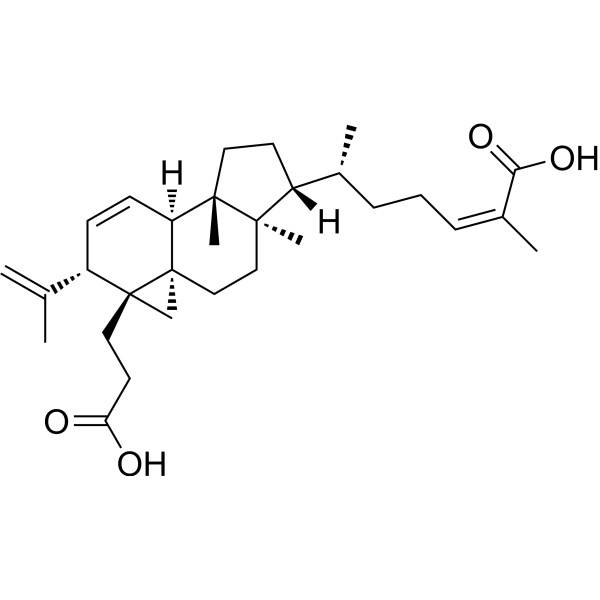Changnanic acidCAS# 136040-44-3 |

Quality Control & MSDS
Package In Stock
Number of papers citing our products

| Cas No. | 136040-44-3 | SDF | Download SDF |
| PubChem ID | N/A | Appearance | Powder |
| Formula | C30H44O4 | M.Wt | 468.67 |
| Type of Compound | Triterpenoids | Storage | Desiccate at -20°C |
| Solubility | Soluble in Chloroform,Dichloromethane,Ethyl Acetate,DMSO,Acetone,etc. | ||
| General tips | For obtaining a higher solubility , please warm the tube at 37 ℃ and shake it in the ultrasonic bath for a while.Stock solution can be stored below -20℃ for several months. We recommend that you prepare and use the solution on the same day. However, if the test schedule requires, the stock solutions can be prepared in advance, and the stock solution must be sealed and stored below -20℃. In general, the stock solution can be kept for several months. Before use, we recommend that you leave the vial at room temperature for at least an hour before opening it. |
||
| About Packaging | 1. The packaging of the product may be reversed during transportation, cause the high purity compounds to adhere to the neck or cap of the vial.Take the vail out of its packaging and shake gently until the compounds fall to the bottom of the vial. 2. For liquid products, please centrifuge at 500xg to gather the liquid to the bottom of the vial. 3. Try to avoid loss or contamination during the experiment. |
||
| Shipping Condition | Packaging according to customer requirements(5mg, 10mg, 20mg and more). Ship via FedEx, DHL, UPS, EMS or other couriers with RT, or blue ice upon request. | ||

Changnanic acid Dilution Calculator

Changnanic acid Molarity Calculator
| 1 mg | 5 mg | 10 mg | 20 mg | 25 mg | |
| 1 mM | 2.1337 mL | 10.6685 mL | 21.337 mL | 42.6739 mL | 53.3424 mL |
| 5 mM | 0.4267 mL | 2.1337 mL | 4.2674 mL | 8.5348 mL | 10.6685 mL |
| 10 mM | 0.2134 mL | 1.0668 mL | 2.1337 mL | 4.2674 mL | 5.3342 mL |
| 50 mM | 0.0427 mL | 0.2134 mL | 0.4267 mL | 0.8535 mL | 1.0668 mL |
| 100 mM | 0.0213 mL | 0.1067 mL | 0.2134 mL | 0.4267 mL | 0.5334 mL |
| * Note: If you are in the process of experiment, it's necessary to make the dilution ratios of the samples. The dilution data above is only for reference. Normally, it's can get a better solubility within lower of Concentrations. | |||||

Calcutta University

University of Minnesota

University of Maryland School of Medicine

University of Illinois at Chicago

The Ohio State University

University of Zurich

Harvard University

Colorado State University

Auburn University

Yale University

Worcester Polytechnic Institute

Washington State University

Stanford University

University of Leipzig

Universidade da Beira Interior

The Institute of Cancer Research

Heidelberg University

University of Amsterdam

University of Auckland

TsingHua University

The University of Michigan

Miami University

DRURY University

Jilin University

Fudan University

Wuhan University

Sun Yat-sen University

Universite de Paris

Deemed University

Auckland University

The University of Tokyo

Korea University
- Foenumoside B
Catalog No.:BCX1817
CAS No.:877661-00-2
- Lysimachigenoside C
Catalog No.:BCX1816
CAS No.:952304-73-3
- Ipalbine
Catalog No.:BCX1815
CAS No.:23544-46-9
- Ipalbidine
Catalog No.:BCX1814
CAS No.:26294-41-7
- Piperkadsin A
Catalog No.:BCX1813
CAS No.:895543-36-9
- Heilaohuguosu G
Catalog No.:BCX1812
CAS No.:2763689-78-5
- Kadsuphilin A
Catalog No.:BCX1811
CAS No.:887770-02-7
- Isolaureline
Catalog No.:BCX1810
CAS No.:475-84-3
- Schisantherin S
Catalog No.:BCX1809
CAS No.:2230512-49-7
- 2,5,6-Trihydroxy-3,4-methoxy-9,10-dihydrophenanthrene
Catalog No.:BCX1808
CAS No.:1810733-76-6
- (2R,3R,5S)-2-(1,3-Benzodioxol-5-yl)-3,5-dihydro-5-methoxy-3-methyl-5-( 2-propenyl) -6(2H)-benzofuran...
Catalog No.:BCX1807
CAS No.:155551-59-0
- Kadsurenin B
Catalog No.:BCX1806
CAS No.:145701-13-9
- Manwuweizic acid
Catalog No.:BCX1819
CAS No.:116963-87-2
- Grandivine A
Catalog No.:BCX1820
CAS No.:200574-22-7
- (7S,8S,1′S)-3,4,1′-Trimethoxy-1′,6′-dihydro-7,4′-epoxy-8,3′-neoligna-8′-en-6′-one
Catalog No.:BCX1821
CAS No.:61240-30-0
- Puberulin A
Catalog No.:BCX1822
CAS No.:164268-04-6
- (S)-(+)-Imperanene
Catalog No.:BCX1823
CAS No.:163634-08-0
- 5-Hydroxy-2-(2′-hydroxy-2-phenylethyl)chromone
Catalog No.:BCX1824
CAS No.:357637-15-1
- Isoguaiacin
Catalog No.:BCX1825
CAS No.:78341-26-1
- Rubriflorin B
Catalog No.:BCX1826
CAS No.:835875-96-2
- Kadsuralignan A
Catalog No.:BCX1827
CAS No.:913237-64-6
- Acetylbinankadsurin A
Catalog No.:BCX1828
CAS No.:77174-33-5
- Kadsulignan H
Catalog No.:BCX1829
CAS No.:144049-91-2
- Schiarisanrin E
Catalog No.:BCX1830
CAS No.:697228-90-3
Triterpenoids from Schisandra propinqua var. propinqua.[Pubmed:30452164]
Nat Prod Commun. 2016 Jul;11(7):925-929.
Four new triterpenoids, propindilactone T (1), propindilactone U (2), Changnanic acid 3-methyl ester (3) and schipropinic. acid (4), together with five known ones (5-9), were isolated and identified from the stems and leaves of Schisandra propinqua var. propinqua; their structures were determined based on spectroscopic and mass spectrometric analyses. The absolute configuration of 1 was confirmed by X-ray analysis. Compounds 1, 2, and 4-9 were tested for their cytotoxic activities against five human tumor cell lines; all were inactive except for 8, which showed weak activity against some of the cell lines.
New triterpenoids from Kadsura heteroclita and their cytotoxic activity.[Pubmed:16557460]
Planta Med. 2006 Apr;72(5):450-7.
Phytochemical investigations of the stem of Kadsura heteroclita (Roxb) Craib (Schizandraceae) resulted in the isolation and structure elucidation of six new triterpenoidal compounds named heteroclitalactones A-E (1-5) as well as heteroclic acid (6) and heteroclitalactone F (7), which was isolated for the first time from a natural source, and the six known compounds schisanlactone E (8), cycloartenone (9), schisandronic acid (10), nigranoic acid (11), Changnanic acid (12) and schisanlactone B (13), respectively. The structures of these compounds were characterized by extensive 1D and 2D NMR spectral analyses. The majority of these triterpenoids showed moderate cytotoxic activity against the human tumor cell lines Bel-7402, BGC-823, MCF-7 and HL-60. Among the compounds tested, heteroclitalactone D (4) showed the strongest cytotoxic activity against the HL-60 cells with an IC50 of 6.76 microM.


